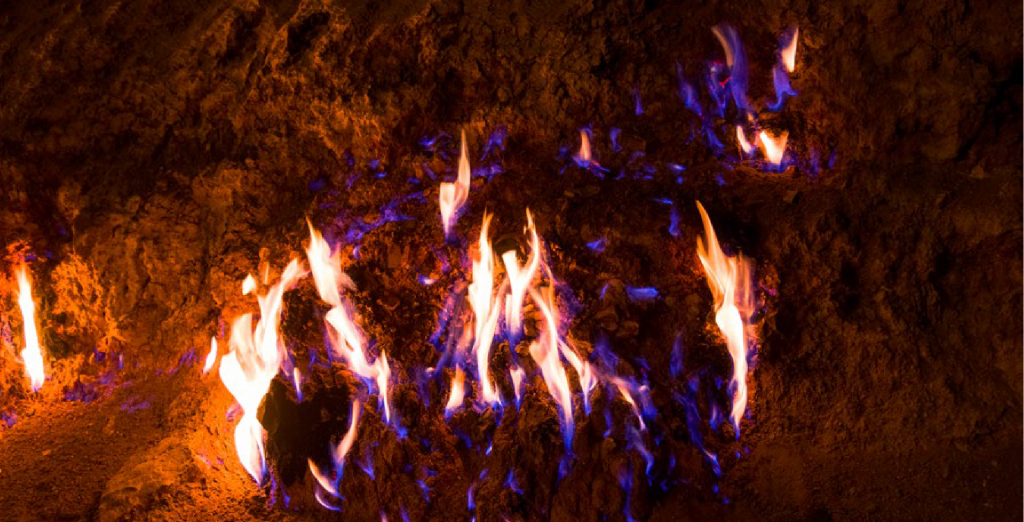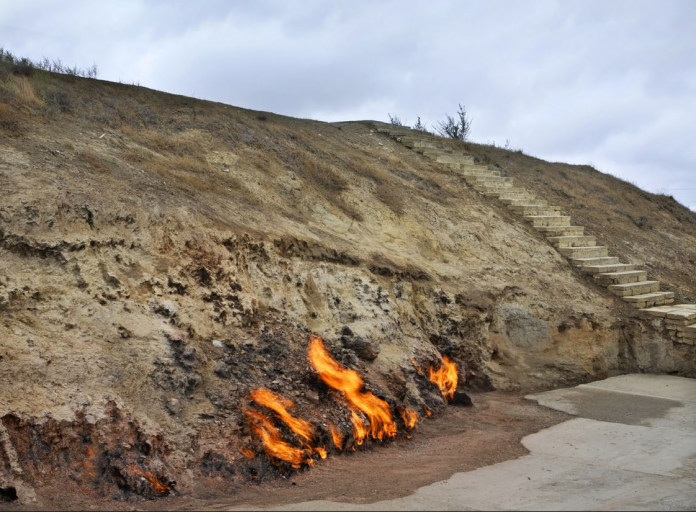Azerbaijan is known as “The Land of Fire”, and aptly so. When Marco Polo visited the then-Persian city of Baku, he wrote about numerous mysterious flames that could be found all over the region: “This is absolutely the most interesting and fascinating thing, which can be seen nowhere else.”
The natural fires of Azerbaijan are considered to have played a crucial part in the ancient Zoroastrian religion, which was founded in Iran and flourished in Azerbaijan in 1000 BC. For Zoroastrians, fire is a link between humans and the supernatural world, and a medium through which spiritual insight and wisdom can be gained. It’s purifying, life-sustaining and a vital element of worship.
Such fires were once plentiful in Azerbaijan, but because they led to a reduction of gas pressure underground, interfering with commercial gas extraction, the exploitation of the reserves in Azerbaijan caused most of the natural fires to burn out. Of the natural fires that burn in Azerbaijan currently, Yanar Dag, translating to “Burning Mountain”, is arguably the most impressive. A 15-metre long wall of fire that never goes out burns continuously alongside the edge of a hill, where flames jet into the air from a thin, porous sandstone layer. The reason offered for the Yanar Dag fires is the result of hydrocarbon gases emanating from below the Earth’s surface.

The Geological Survey of Azerbaijan describes Yanar Dag as having “intensive flames, [up] to 1 metre high, developed for 15 metres along the base of a 2–4-metre- high and 200-metre-long tectonic scarp”. According to the study carried out by the scientists, analyses of four samples taken from Yanar Dag revealed that the area of maximum flux was situated at the upper side of the fault scarp, in the area from which the flames emanate. It has been inferred that the degassing area is larger than the measured area, and it is very likely that the microseepage is pervasive along the fault zone. This fault scarp is inferred as a part of the huge Balakhan-Fatmai structure on the Absheron Peninsula.
Whatever the reason, this fire has burned continuously for 4,000 years. The experience is most impressive at night, or in winter. When snow falls, the flakes dissolve in the air before even reaching the ground.
Unlike mud volcanoes in Baku, which are widespread in Azerbaijan, there is no seepage of mud or liquid at Yanar Dag, and the flames burn steadily. Around this open fireplace, the air is permeated with the smell of gas. But that is not all: The constant Absheron wind makes this place even more mysterious by creating bizarre forms of flames.
Tongues of fire also rise from the surface of streams located near the hill, which are known as Yanar Bulaq, or “burning springs”. The Yanar Bulaq springs may seem harmless, but they can easily be ignited by accident, such as with a carelessly discarded lighted matchstick. This is because the spring water is saturated with sulphur. However, locals believe in the curative properties of the springs and spend hours taking footbaths there.
Azerbaijan is blessed with vast natural gas and oil deposits which make this unique phenomenon possible. The history of Yanar Dag is shrouded in mystery, but a local legend goes that a shepherd once accidentally lit a fire there and the hill has been burning ever since.
Source: Azernews, Baku Travel Guide, Geological Survey of Azerbaijan
Read the rest of the article in Asian Geographic No.142 Issue 3/2020 here or download a digital copy here!











